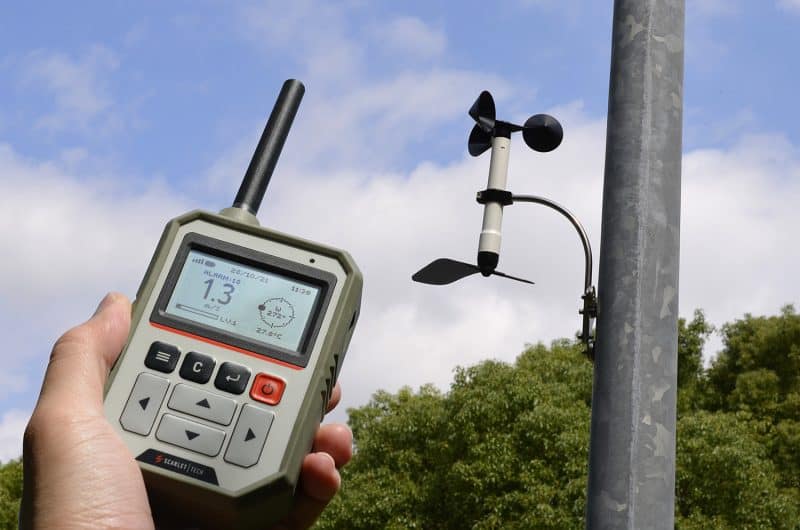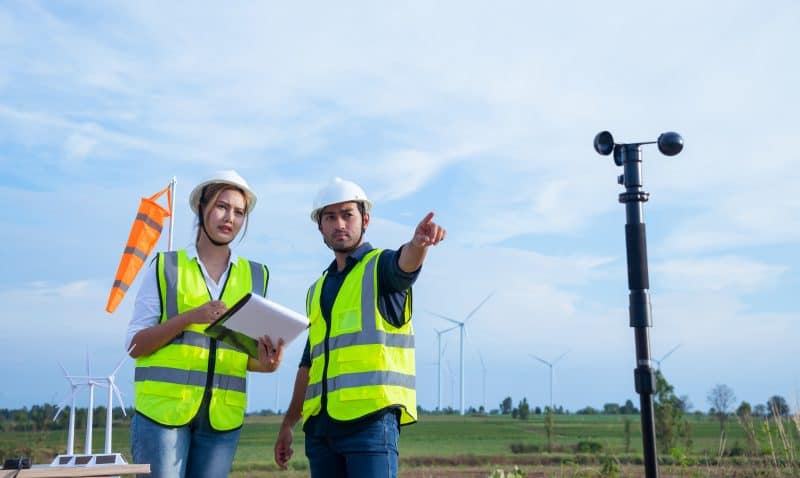4 Types of Anemometers: How to Choose the Right Tool for Accurate Wind Measurement
Accurate wind measurement is crucial across various industries, including construction, renewable energy, and industrial automation. Anemometers, the instruments designed to measure wind speed and direction, play a vital role in ensuring safety, optimizing performance, and facilitating research. This guide will walk you through the different types of anemometers, their applications, and guidance on selecting the appropriate model for specific needs.

What Is an Anemometer?
An anemometer is a device used to measure wind speed and, in some cases, wind direction. Originating from the Greek word “anemos”, meaning wind, anemometers are essential tools in meteorology and various industrial applications. They provide critical data for weather forecasting, aviation, marine navigation, and structural engineering.
In industries like construction and renewable energy, understanding wind patterns is vital. For instance, in construction, monitoring wind speeds ensures crane operations’ safety, while in wind energy, it aids in turbine placement and efficiency optimization. Industrial automation systems also rely on accurate wind data to maintain environmental controls and ensure equipment longevity.
Types of Anemometers
Anemometers come in various designs, each suited to specific applications and environments. The primary types include:
1. Cup Anemometers
Cup anemometers consist of three or four hemispherical cups mounted on horizontal arms, which rotate around a vertical axis. The wind’s force causes the cups to spin, with the rotation speed proportional to wind velocity. These devices are widely used in meteorological stations, environmental monitoring, and research due to their simplicity and reliability.
2. Vane Anemometers
Vane anemometers feature a propeller connected to a tail vane, aligning the device with the wind direction. As the wind turns the propeller, the rotational speed is measured to determine wind velocity. They are commonly used in HVAC systems and environmental monitoring.
3. Hot-Wire Anemometers
Hot-wire anemometers measure wind speed based on the cooling effect of air flowing over a heated wire. The rate of cooling, and thus the change in electrical resistance, correlates with wind velocity. These are highly sensitive instruments used in laboratory settings and airflow studies.
4. Ultrasonic Anemometers
Ultrasonic anemometers use sound waves to measure wind speed and direction. By sending ultrasonic pulses between transducers and measuring the time it takes for the pulses to travel, they calculate wind velocity. These devices have no moving parts, making them suitable for harsh environments and long-term installations.
5. Laser Doppler Anemometers
Laser Doppler anemometers utilize the Doppler shift principle, where a laser beam is split, and one part is directed into the airflow. Particles in the air scatter the light, and the frequency shift between the emitted and received light is used to calculate wind speed. These are precise instruments used in research and complex fluid dynamics studies.
6. Pitot Tube Anemometers
Pitot tube anemometers measure wind speed based on pressure differences. As wind flows into the tube, it causes a pressure change, which is measured and converted into velocity. These are commonly used in aviation and industrial applications where airflow measurement in ducts is required.
How to Choose the Right Anemometer

Choosing the right anemometer is critical to ensure accurate, reliable wind measurements for your specific needs. Different industries and environments demand different performance features, durability levels, and compliance standards.
Application Requirements
Identify the specific use case—such as meteorological research, HVAC monitoring, or industrial process control—to choose the right sensor. For example, ultrasonic anemometers are ideal for environmental monitoring due to their precision and durability. Devices like the EM-30 Industrial Weather Station, designed for worksites, also use ultrasonic sensors for accurate wind measurement in rugged conditions.
Environmental Conditions
Consider the operating environment. In harsh or explosive atmospheres, explosion-proof models like Scarlet Tech’s E11 are necessary. For indoor applications with controlled conditions, hot-wire or vane anemometers may suffice.
Measurement Range and Accuracy
Determine the required measurement range and accuracy. High-precision tasks, such as laboratory experiments, demand sensitive instruments like laser Doppler anemometers, while general weather monitoring can utilize cup or vane types.
Connectivity and Data Output
Assess the need for data integration. Modern anemometers offer various outputs, including analog, digital, and wireless options. Devices with app integration or cloud connectivity facilitate real-time monitoring and data analysis.
Portability vs. System Integration
Decide between portable units for field measurements and fixed installations for continuous monitoring. Portable devices like Scarlet Tech’s WR-3 Plus are suitable for temporary setups, while integrated systems like WindPro are designed for permanent installations.
Certifications and Compliance
Ensure the anemometer meets industry standards and certifications, such as ATEX or IECEx, especially for use in hazardous environments.
Calibration and Maintenance Needs
Consider the maintenance requirements and ease of calibration. Instruments with fewer moving parts, like ultrasonic anemometers, typically require less maintenance.
Scarlet Tech Anemometer Solutions
Scarlet Tech offers a range of anemometers tailored to diverse applications:
WR-3 Plus Wireless Anemometer
The WR-3 Plus is a portable, wireless anemometer equipped with a handheld receiver and a wind sensor. It provides real-time wind speed data and features adjustable alarms for safety. Ideal for construction sites and mobile operations, it ensures safety in crane and lift activities.
WindPro 4–20mA Anemometer Controller
WindPro is an industrial-grade anemometer with analog output, designed for integration with PLCs and SCADA systems. It offers reliable wind monitoring for industrial automation and process control.
Online WindPro
The Online WindPro is a cloud-based wind monitoring system designed for long-term data logging and remote access. It features a web portal that allows users to monitor wind data from multiple devices, receive instant alerts via email or browser notifications, and export data logs for analysis. With a wireless range of up to 1,000 meters, it supports integration with various IIoT systems through outputs like 4-20mA, RS232, USB, and Wi-Fi. The system is ideal for continuous site monitoring in remote industrial setups, ensuring safety and operational efficiency.
E11 Explosion-Proof Anemometer
The E11 Explosion-Proof Anemometer is specifically designed for hazardous environments, such as oil and gas industries. Certified with ATEX approvals (EX II 2 G EX ib IIB T4), it ensures safe operation in explosive zones. The device boasts a rugged, waterproof design (IP67), a wireless transmission range of up to 1,300 meters, and a battery life of up to 3 years. It includes built-in alarms and supports integration with external systems via 4-20mA outputs, making it a reliable choice for monitoring wind conditions in challenging environments.
Explore Wind Monitoring Solutions from Scarlet Tech
Accurate wind measurement is vital for safety and efficiency across various industries. Scarlet Tech offers a comprehensive range of anemometers tailored to meet diverse operational needs—from portable, wireless models for construction sites to explosion-proof devices for hazardous environments. Each product is designed with precision, durability, and user-friendliness in mind, ensuring optimal performance in any setting.
Discover the full suite of Scarlet Tech’s wind monitoring solutions and select the model best suited to your environment and operational requirements. Visit our website to learn more and make an informed choice for your wind measurement needs.
